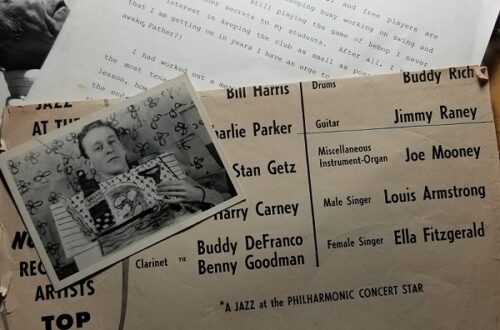(by Jon Raney © 2008)
Modern Jazz lines are frequently comprised of a combination of 2 to 3 elements in a phrase unit consisting of:
- scale fragments
- arpeggios and/or harmonic intervals
- auxiliary tones (neighbor & passing tones, turns)
Scale fragments are typically these types of 4 note constructions, consisting of either 4 consecutive notes or 3 with a skip: 1234 1235 1345
- They can be applied modally: 3456 5672 7123
- Can be root-reinterpreted (really the same thing as a mode):
1235 in C = 3457 in A-7 - Can be varied in terms of:
- direction: 1235 = 5321
-
note order: 2135
- intervallic construction: 3 (6th down) 5 6 7
- Or any combination of these basic manipulations
Arpeggios are typical triadic, seventh or extended, and root reinterpreted:
135, 357, 13579 Eb over F = F9sus (7 9 11)
Manipulations of triads can be effected the same way as scale fragment with changes in direction, order and interval (also inversions):
- 3 (down) 5 6 1
- 5 3 1 7 (up)5
Auxiliary tones in jazz are generally simplified to neighbor, passing tones and turns. Passing tones are bridging notes between two tones. Neighbor tones are notes that move to a specific target tone either above or below. In jazz, neighbor tones are usually in pairs referred to as double neighbors or enclosures (Ex: b2 7 1) Multiple passing tones are frequently used in bebop lines to connect one chord tone to another (for ex. 5-#5-6-b7-nat7). Turns are similar to neighbors but they are inclusive of the target note itself (see bolded) 2 1 7 1
To gain facility in combining these elements and expanding line vocabulary, a useful technique is theme and variations. In a jazz context, this involves a practice of taking one part of a melodic line as fixed and then varying the latter half. This helps build variety and idea possibilities which help keep the interest both for the soloist and the listener. Below are various II-V I examples that take this approach. The examples here are only in C. The student will need to transpose the phrases to other keys. Note also that ex# 1-4 are one measure II-Vs and ex 5 is 2 measure example.
Ex.1 Uses 1234 on D-, U.S inverted E triad over G7 and finishing double neighbor
Ex. 2 Same start on D-7, U.S Db7 arpeggio down, harmonic interval and double neighbor (one chromatic)
Ex. 3 with Ab-#7 over G7 arpeggio
Ex. 4 with D-7 arpeggio and 1/2W dim over G7
Ex. 5 1234 SF, 5 7 9 11 arpeggio over D-7, U.S. Ab-9 over G7 and passing tones
More examples next time!
Discover more from The Raney Legacy
Subscribe to get the latest posts sent to your email.


